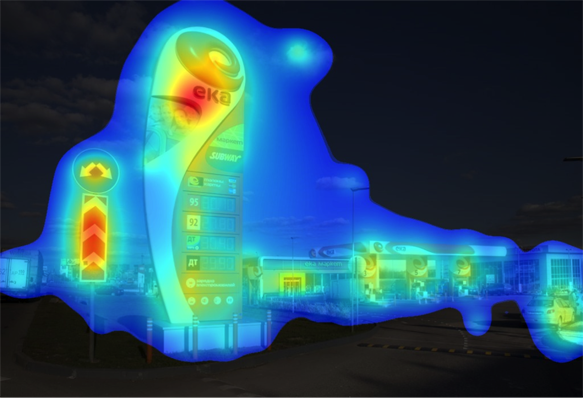Design aesthetics are but a small part of what commercially minded forecourt specialists need to consider in planning effective roadside retail designs.
Evidence suggests that the first 3-5 seconds on approaching a forecourt is critical in positively shaping motorists' refuelling and shopping behaviour.
In today’s competitive fuel retail landscape, these precious seconds are of paramount importance in communicating the salient benefits of the roadside offer. Each design element must be fine-tuned to convey, in order of significance, the branding and value propositions as well as leverage any synergies that exist between the fuel retailer’s brand and its affiliate partners.
In the case of EKA, predictive research incorporating 3M Visual Attention Service (VAS) was adopted to test the effectiveness and comparative strength of branded signage elements (totem, canopy, pump island forecourt, etc) against other elements across a motorist’s line of vision (public warning signs, Toyota showroom).
It is no surprise that the main identification sign was the first design element that visitors noticed when entering the facility. Eye-tracking research allowed the Minale Tattersfield design team to make pre-emptive modification of branding elements relating to dimensional size of logotype in relation to sub-brand (Ekamarket) and partner brand (Subway), as well as fine-tune hierarchical messages (fuel price, payment method, c-store facilities, etc) to optimise the offer towards defined target audiences.
Such research permits greater level of confidence and reassurance during the design approval stage and in EKA's case was particularly important as a comparatively high level of investment in network upgrade and tight project deadline necessitated an empirically proven design approach.
Evidence suggests that the first 3-5 seconds on approaching a forecourt is critical in positively shaping motorists' refuelling and shopping behaviour.
In today’s competitive fuel retail landscape, these precious seconds are of paramount importance in communicating the salient benefits of the roadside offer. Each design element must be fine-tuned to convey, in order of significance, the branding and value propositions as well as leverage any synergies that exist between the fuel retailer’s brand and its affiliate partners.
In the case of EKA, predictive research incorporating 3M Visual Attention Service (VAS) was adopted to test the effectiveness and comparative strength of branded signage elements (totem, canopy, pump island forecourt, etc) against other elements across a motorist’s line of vision (public warning signs, Toyota showroom).
It is no surprise that the main identification sign was the first design element that visitors noticed when entering the facility. Eye-tracking research allowed the Minale Tattersfield design team to make pre-emptive modification of branding elements relating to dimensional size of logotype in relation to sub-brand (Ekamarket) and partner brand (Subway), as well as fine-tune hierarchical messages (fuel price, payment method, c-store facilities, etc) to optimise the offer towards defined target audiences.
Such research permits greater level of confidence and reassurance during the design approval stage and in EKA's case was particularly important as a comparatively high level of investment in network upgrade and tight project deadline necessitated an empirically proven design approach.




1 comment:
Great stuff from Minale as always. Good to see VAS being used in this environment and it just goes to show that it can be objectively proven that a design in this environment meets its goals... within seconds!
Post a Comment